Challenges and opportunities for harvesting New Zealand’s farm forest blocks
Kristopher Brown, New Zealand Tree Grower February 2018.
For the owner of a small-scale forest or woodlot who is preparing to harvest there are many points to consider. These can include financial returns, health and safety, environmental protection, interruptions to farming activities, property damage, logging residue and site clean-up. A previous study which documented land owner satisfaction with harvesting found that the main piece of advice they would give to a fellow woodlot owner was to choose your logging contractor carefully.
However, logging contractors also face considerable problems and concerns when harvesting woodlots. Our research highlights, from the harvesting contractors’ perspective, some of the main issues and considerations related to economic feasibility, health, safety, environmental protection and site clean-up. The loggers interviewed were selected based on recommendations from satisfied land owners, as identified by the Brown and Visser study in 2017. In addition, a day was spent observing each logging crew to obtain examples of the harvest systems, machines and operating principles they use to solve woodlot harvesting problems. The purpose of this article is to highlight how these aspects have resulted in positive results for the woodlot owner.
Issues and considerations
New Zealand’s woodlot forests represent a significant portion of the rapid increase in recoverable forest volume, adding 10 to 15 million cubic metres a year to the total recoverable volume from now into the 2020s. Many of the woodlots are small blocks of forest scattered throughout the countryside. A recent survey of 364 woodlot owners found that about two-thirds of these woodlots are 40 hectares or less. As such, more loggers will be required to harvest woodlots in the near future.
Woodlot harvesting has unique challenges for a logger in comparison to larger commercial forests. In terms of economics, the smaller the woodlot, the more difficult it is to absorb the cost of building infrastructure such as roads and landings, as well as transporting logging machines from site to site. Moving equipment can cost $5,000 to $10,000 for each move. Site clean-up requirements and implementation of best management practices to protect water quality may also be higher.
Some problems
Woodlots were often planted on the steepest, least productive or erodible parts of the farm, which means that harvesting costs are higher in such difficult terrain. Felling and processing trees can be complicated by the edge-effect, where trees around the outer edge of the block are leaning, have stem sweep because they have been more exposed to wind and have large diameter branches. The edge-effect is inversely proportional to block size and shelterbelts are a prime example.
Additional challenges for shelterbelts include mature trees which are too big for mechanical felling and processing. Furthermore, logging on farms may require directional felling to avoid damaging fences which may need to be opened up so that logging machinery can get access to the woodlot.
Existing infrastructure suitable for logging system access and trucking operations is generally limited and building new roads or upgrading existing farm tracks to provide access for on-highway log trucks can be too expensive in comparison to the total volume of merchantable wood available. As a result, many landowners and loggers prefer to harvest during the summer when drier farm infrastructure and paddocks can support logging machine traffic
Some challenges
All of these factors affect the production rate of harvesting operations, which is critical for logging contractors, as they must meet the daily cost of owning, operating, and maintaining their logging machines and pay their crew members. Woodlot logging specialists also face periods of lower activity when the market price drops and land owners defer their planned harvests, as well as a cyclical drop during the winter due to land owners not wanting to risk wet-weather harvesting.
While woodlots share many of the same safety hazards as larger commercial forests such as steep and uneven land requiring motor-manual felling and powerlines, there are some additional hazards, such as controlling site access. For example, land owners, farm contractors or neighbours could arrive at the site unannounced and be unfamiliar with logging site safety procedures.
Woodlot harvesting also represents some unique challenges related to environmental protection. For example, wet weather harvesting can easily turn into a mess without the investment in a higher standard of infrastructure. In addition, good practice for post-harvest remediation of skid trails is to install water bars spaced according to trail gradient and soil erodibility and to use slash to provide immediate surface cover. However, if the land owner wants to keep trails open, alternative techniques may be required to control run-off and erosion.
The site visits
In addition to the interviews, a day was spent with each of the three recommended loggers to obtain examples of the harvesting systems, machines and or operating principles they use to address woodlot harvesting issues. All site visits were completed in May 2017.
Peter Davies-Colley operation
On the day of the visit, Peter Davies-Colley and his crew in Northland were extracting cut-to-length logs from two woodlots each only 0.4 hectares. They still had another block to harvest on the property and Peter estimated that a total of 1,000 tonnes of logs would be recovered. This volume is equivalent to about 10 days of full-time work for the crew.
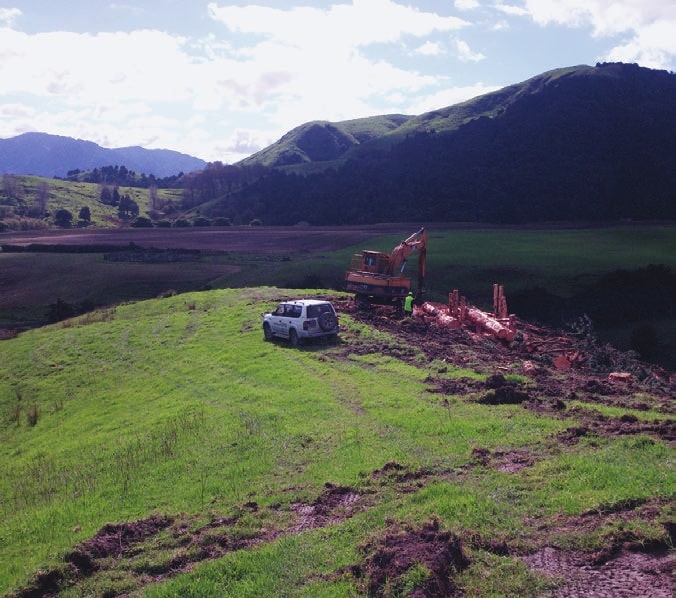
A Hyundai 290 excavator with a LogMax 1000XT harvesting head was used to fell and de-limb stems in the forest. This is an example of reducing the cost associated with equipment transport by using multi-purpose machines. The branches and needles are good for nutrient retention on site and this slash acts as a mat for machine traffic which helps to reduce soil disturbance.
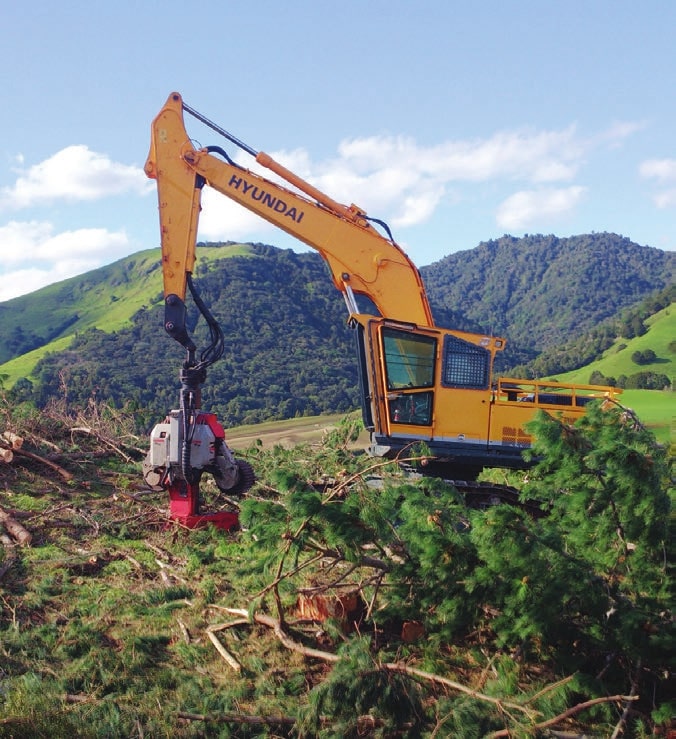
The Hyundai 290 also shovelled stems to a processing area accessible to an off-highway truck, which forwarded the logs to a road-side landing. This system of processing and extraction is called two-staging because logs are processed in one location in the forest and loaded on to log trucks in another at the road-side landing. Regarding shovel logging, Peter said, ‘It is a highly efficient extraction technique up to 100 metres and can be quite useful for up to 300 metres. It can be used on quite difficult terrain as long as a tracked loader can gain access. It works much better for downhill logging than uphill. We often shovel-log in what would be called hauler or cable-logging country’.
At the processing area, log storage was achieved by plunging a row of logs into the earth, which prevented stacked logs from rolling downhill. This method avoids the cost and environmental disturbance associated with earthworks to form a landing. In this case, it was a viable option because the log volumes at the two woodlots were relatively low. Peter minimises the quantity of offcuts left behind by taking all logging residue off-site as pulp. For short transportation distances to the market this also helps to increase economic returns to the landowner.
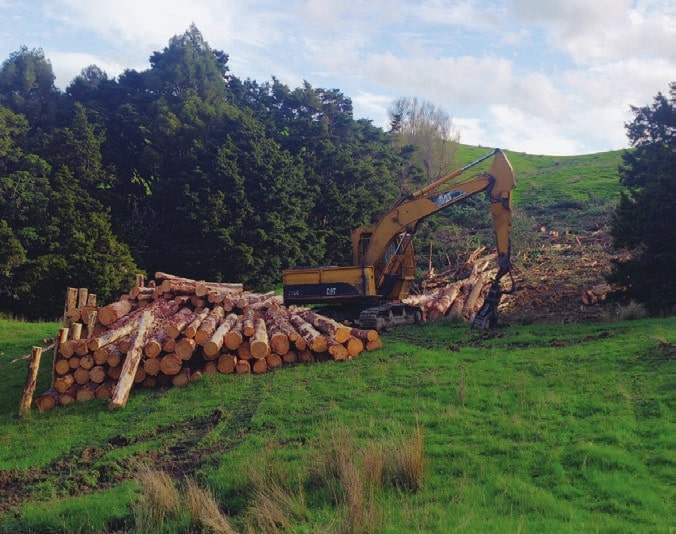
A MAN 18-284 off-highway truck forwarded logs 1.8 km from the woodlot processing area to the road-side landing. Most of this journey was on a rural road, with only 300 metres across the paddocks. On the day of the crew visit, the truck made 20 such round trips.
The off-highway truck was a four-wheel drive fertiliser spreader, now modified with bolsters and a headboard.
Peter and his crew are careful not to overload the off-highway truck, which reduces vehicle damage, cycle times, and maintains continuous production. A typical payload is around eight tonnes with a maximum of 10 tonnes. A similar truck is featured in an article in the February 2013 edition of Tree Grower entitled ‘Where there is a will, there is a way – Harvesting at Collyns Forest’.
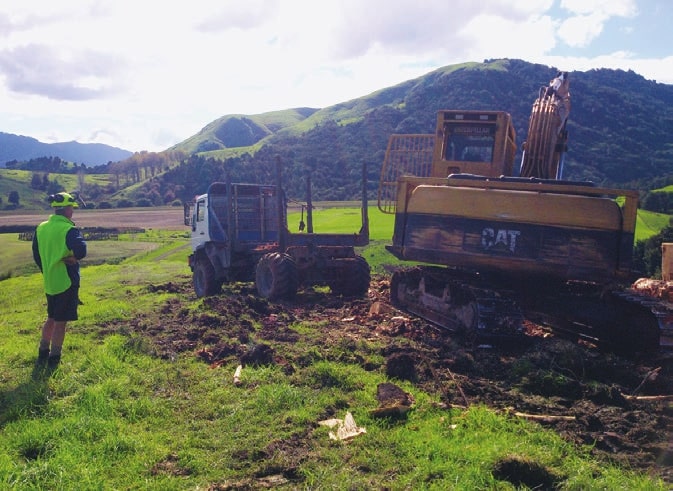
This extraction system eliminates the need for road construction as the off-highway truck simply drives across the paddock. It is a potential solution when woodlot access is limited, harvest volumes are small and the weather is dry. Such innovative systems may provide solutions for small woodlots which are otherwise uneconomic to harvest. One of the constraints of the off-highway truck as used in this system is that it requires a loader at each end, one at the processing area and one at the road-side landing.
A Kobelco SK2355R excavator with a grapple attachment unloaded the off-highway truck at the road-side landing and organised the logs into stacks by log grade. It also loaded on-highway log trucks when they arrived. The width of the Kobelco excavator to the outside of the tracks is only 3.4 metres and its tail swing radius is 1.8 metres, which makes it a useful loading machine in tight spaces.
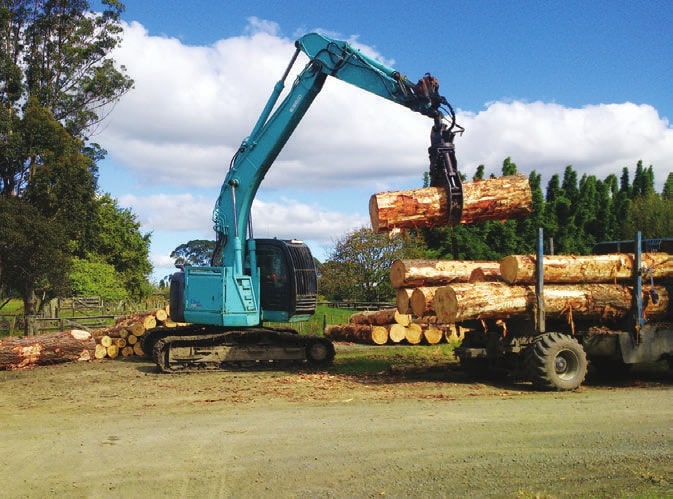
Rob Leslie operation
On the day of the visit, Rob Leslie and his crew in Northland were harvesting a block of about three hectares using a two-stage operation. As with Peter Davies-Colley’s harvesting, stems were processed into logs at a small, makeshift processing area at the edge of the cutover. Logs were loaded on to a forwarder and moved about 350 metres from the processing area to the loading area accessible to highway log trucks. A farm track provided forwarder access from the load-out area to the processing area.
Rob’s crew had recently completed a larger block of about five hectares using the same system and he estimated that this would be involve about 4,000 tonnes of logs in total. The crew’s production aim was seven to eight truck loads a day or about 210 to 240 tonnes a day.
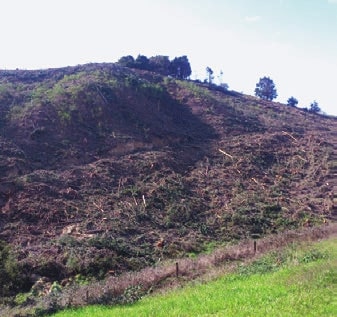
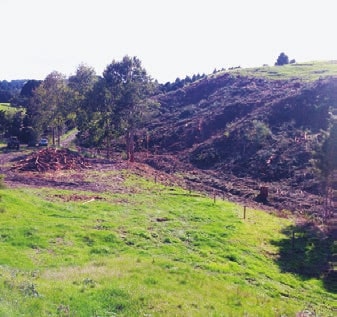
The equipment used was a Hitachi ZX280 with a 630 Satco felling head and a 950 Timberjack with 624 Super Waratah fell and delimb head to fell and delimb stems in the forest. A John Deere 748 G3 grapple skidder was used to skid stems to a makeshift processing area. This skidder was also capable of winching stems up to the skid trail.
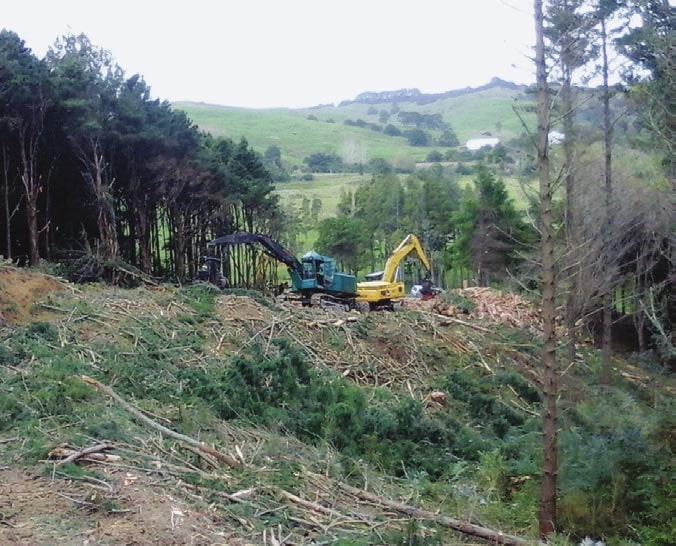
A PC 300-8 excavator with a 625C Waratah processing head was used to process stems into logs. A Komatsu PC200-7 excavator with a grapple attachment worked alongside the processor to sort and stack the logs in preparation for loading them on to a CAT 574 eight-wheel drive forwarder.
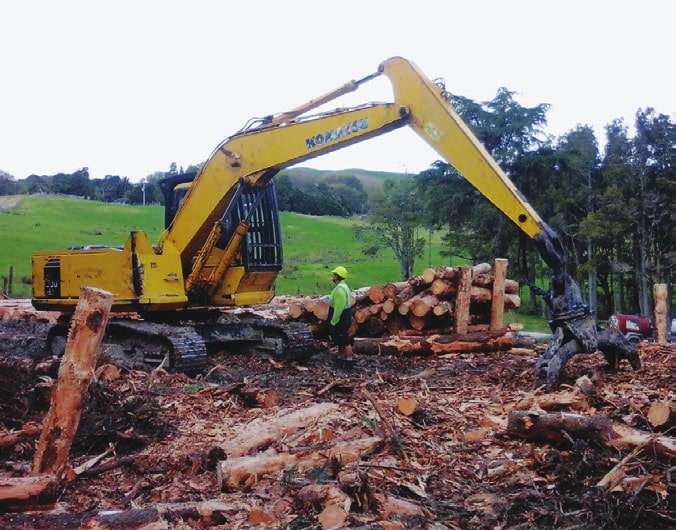
A Komatsu PC 220-8 grapple loader worked at the load-out area to off-load larger logs from the forwarder, arrange logs by grade and load highway log trucks. In summary, both operations discussed so far have used two-stage operations, where logs are cut-to-length in forest processing areas and forwarded to a load-out area accessible to log trucks.
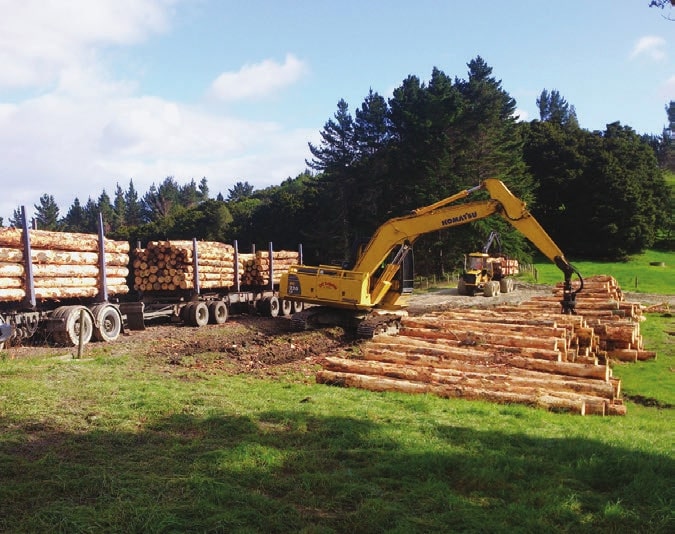
Tom Murray operation
Tom Murray of Hurunui Logging and his crew were harvesting a 10-hectare block of radiata pine 23 to 24 years old. Tom estimated that this would be a 5,000-tonne project and the daily production target was 300 to 350 tonnes. Trees were mechanically felled and shovelled downhill to a skid trail where they were bunched for extraction by a Tigercat 630E grapple skidder. Tom explained that mechanical felling and shovelling reduces the amount of tracking necessary. In this case, a single skid trail was used without the need for side spurs off the main skid trail to reach the cut trees. A Sumitomo SH200 with an excavator bucket attachment was used to construct the skid trail.
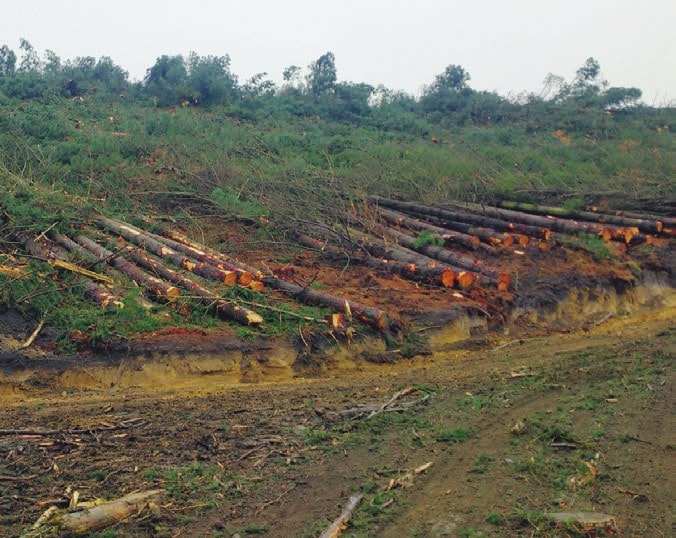
After completion of felling at the back of the block, the maximum extraction distance to the landing adjacent to the road would be about one kilometre. For a large-scale forest operation, additional landings would have been constructed to reduce the extraction distance and improve efficiency However, Tom and the land owner decided not to construct another landing near the back of the block. This was a trade-off between increased costs associated with constructing another landing and providing access for highway log trucks.
The grapple skidder fed bunches of cut stems to the processor, which was a Tigercat H855C with a Waratah processing head. The processor was cutting eight to 12 different log grades. Compared with the previous two-stage operations, this project required a larger landing for processing, log storage and loading on to highway log trucks, similar to those used in commercial forest harvests. However, this woodlot harvest had more log volume, more log grades and the woodlot was one contiguous block. A Hyundai 250 LC-9 excavator with a grapple loaded highway log trucks. It was a wet day, so the log trucks needed a push to be able to leave the landing.
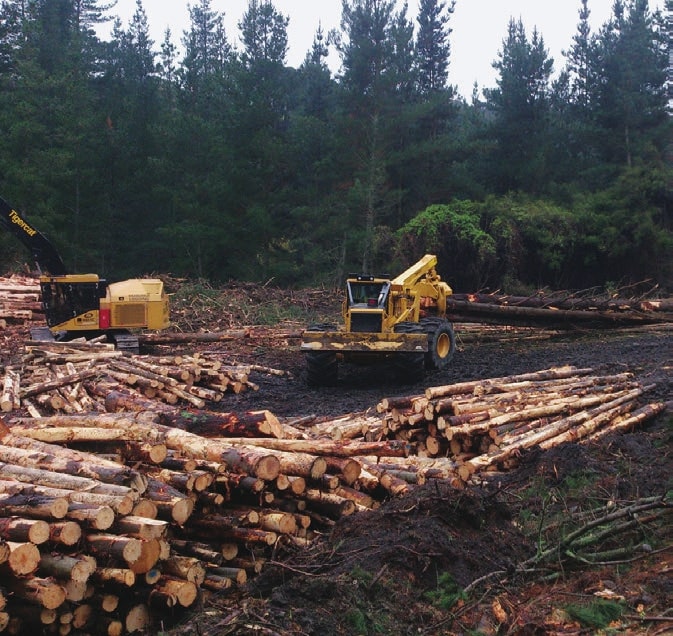
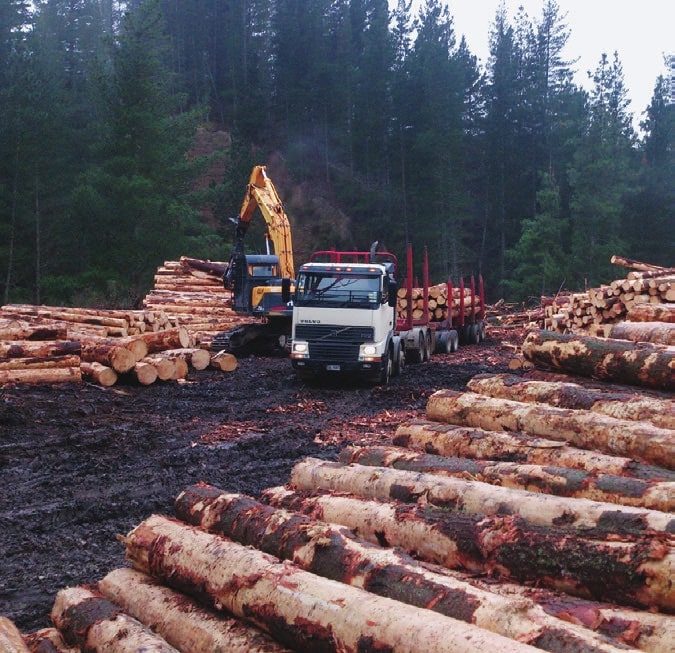
Logging contractor interviews
Economic feasibility
In an ideal situation, what machinery or system is best suited to woodlots?
Ground-based harvesting such as shovel logging was a popular response. One common theme was the benefit of having flexibility in logging machinery so that the most appropriate machines could be selected for the job given site-specific differences in terrain, piece size and harvest area.
For example, Rob has a 700-tonne logging project that will require just three machines − the 950 Timberjack, the CAT 574 forwarder, and a grapple loader. In another example, Rob will use a PC 300-8 excavator with a 625C Waratah processing head, a skidder and a 220 Komatsu grapple loader. This will be for a harvest project which includes 60 to 70-year-old shelterbelts and a 25-year-old radiata pine plantation.
Another common theme was the recognition of the steeper land associated with many of the woodlots due to be harvested. As such, cable yarding options with low transport costs and reduced set-up times are generating interest. Peter is interested in the prospects for yarding loader and excavators, Tong Throwers, Harvestlines, and Bell Haulers related to steep terrain woodlot harvesting. Tom is interested in the use of tethered machines to enable ground-based harvesting on steeper terrain.
Give one or two examples of how your harvest systems, machines, and logger operating principles lead to land owner satisfaction with the overall financial result?
Responses included optimising logging infrastructure and machine transport costs, using the appropriate team of machines for effective and efficient harvest completion and establishing good communication with the land owner about realistic nett returns from harvesting.
Give one or two examples of how your harvest systems, machines, and logger operating principles lead to land owner satisfaction with value recovery.
Peter said that the key point is the harvest manager and logger’s attitude. They need to focus on optimisation of value for the forest owner. They need to understand what value is and how to achieve this for the land owner.
Rob provided some valuable examples, including the use of mechanised felling to minimise stem breakage. He said that you can also use the Waratah to minimise nodal swelling in the log. This can mean the difference between an A and a KI grade log − a difference of $20 a tonne. Rob said that he is one of the very few logging contractors paid on log grade, an incentive to cut the maximum amount of the highest value logs.
Safety
How is managing health and safety different in woodlots compared to large commercial operations?
A common theme was that woodlots are often quite exposed to access and control is very difficult. For example, people such as the landowner, farm contractors or neighbours can approach from all directions and they may not always be aware of logging safety procedures. Therefore, loggers need to have a much higher level of awareness.
The edge effect and difficult felling conditions also featured heavily in the discussions. For example, trees with large branches or leaning trees can require careful directional felling. Large trees or steep, uneven land may require motor-manual felling, which comes with greater safety risks than mechanical felling. Overall, the logging contractors agreed that many hazards are similar to those of commercial forest harvests, but that the diversity of hazards associated with woodlots is probably greater. Examples may include power lines, fences, houses and steep land − trying to use ground-based harvest systems in areas that should probably be cable-logged.
Environmental protection
Give one or two examples of how your harvest systems, machines or logger operating principles lead to the protection of water quality.
All talked about the benefits of mechanical felling and shovel logging to avoid sensitive areas such as stream channels. Directional felling can help to reduce the amount of logging slash deposited in the stream channel. Shovel logging can also reduce the earthworks necessary for skid trail construction. Another example included de-limbing stems at the stump, which retains nutrients on site and creates a slash mat for machine traffic
Peter’s off-highway truck extracted cut-to-length logs from the forest, across the paddock, and out to a roadside landing, effectively eliminating the need for earthworks. Where road construction is necessary, all logging contractors discussed the importance of cut-outs for water control, applying slash on skid trails for surface cover, applying grass seed to farm tracks in the winter and using silt traps to prevent sedimentation of streams.
Tom discussed the importance of removing temporary stream crossings, such as culverts and log crossings. He also noted that post-harvest inspections are used to identify environmental problems and that loggers can be called back to the site to remediate these.
Logging residue and site clean-up
Provide one or two examples of how you address potential concerns with logging residue.
Peter said that he takes logging residue off-site as random pulp, reducing residue volume and increasing financial returns for the land owner. Tom and Rob pile offcuts from processing in a tidy heap which can be burned by the landowner.
Discussion
With regard to small farm forest blocks, what are some logging contractors getting right that others are not?
Responses included optimising value for the land owner as well as understanding farm forester needs and values. This could mean doing your best to protect fences or work around milking schedules. Tom placed a high importance on how you leave a logging job. He said that fence repair or reinstallation is the first thing a farmer will do after harvesting, so you should make sure fences are cleared of logging slash. Tom also noted that mechanised felling has been a big advantage for protecting fences, cleaning up slash, and minimising paddock disturbance. by reducing skid trail construction.
Rob focused on transparency with regard to a logger’s performance record. He said that references will point to a good result. Give prospective clients the opportunity to talk to the last three land owners who used your logging services.
Describe the challenges to operating a profitable farm forest harvest from the logger’s perspective.
As discussed earlier, the smaller the woodlot, the more difficult it is to overcome harvesting costs. Without the advantages afforded by economies of scale, harvesting costs such as machine transport and infrastructure, as well as a logger’s high capital cost, can be quite large. Handling the logistics of frequently moving equipment can be difficult A large edge effect also presents problems for efficient and safe tree felling.
Another common theme was the problem of continuity of work. Fewer land owners want to harvest during winter because of lower export log prices and the risk of wet-weather harvesting without proper infrastructure. Some woodlot harvesting specialists harvest shelterbelts just to keep a good crew working. Rob said, that it is hard to get the good ones back, so you try to work them through the winter. Peter has an alternative plan for the winter, where the focus shifts to machine maintenance and crew members help with Peter’s milling operation or gain experience working in other logging crews.
Conclusions
This study examined logging contractors who specialise in harvesting woodlots to understand more fully the harvest systems, machines and logger operating principles which have resulted in good results for farm forest owners. The interviews with logging contractors and observations of their logging operations were used to synthesise woodlot harvesting challenges and highlight logger strategies for addressing these challenges.
An important finding was that harvesting and roading cost control is critical for the profitability of small woodlot harvests. Steep and rugged terrain, erodible soils, fences, gnarly edge trees and oversized trees were among the factors identified
However, these problems were met with innovative harvesting strategies. For example, multipurpose machines used to fell, delimb, shovel and process stems can reduce the total number of machines required, therefore reducing equipment transport costs.
During dry weather, forwarding cut-to-length logs from the woodlot to a road-side landing via farm tracks or paddocks reduces or eliminates the need for upgrading or constructing new roads for highway truck access to the property. Shovel logging can reduce the amount of tracking required and is particularly useful for downhill extraction distances up to 300 metres. Each of the loggers also recognised the increasing importance of steep-land harvest systems applicable to woodlots.
Examples included tethered machines to enable ground-based extraction on steeper land, as well as cable yarding with low transport costs and reduced set-up times.
Finally, loggers highlighted that a good harvest result, from the perspective of the farm forest owner, requires compassion for farm-related values and protecting them values during harvest time. Examples included protecting fences, working around stock movements, reducing interference with normal farming operations and site clean-up to ensure a tidy job. The results of this study can be used by farm forester owners preparing to plant or harvest woodlots or by other logging contractors that specialise in harvesting woodlots.
Acknowledgements
The author would like to thank Peter Davies-Colley, Rob Leslie, Tom Murray, and their logging crews for their hospitality and insights, which formed the basis of this research article. This project was funded and supported by the Neil Barr Foundation.
Kristopher Brown is a Post-doctoral Fellow at the School of Forestry, University of Canterbury.

 Farm Forestry New Zealand
Farm Forestry New Zealand